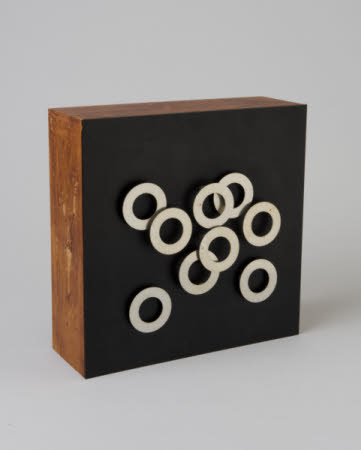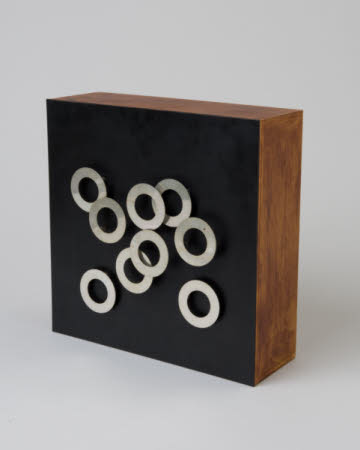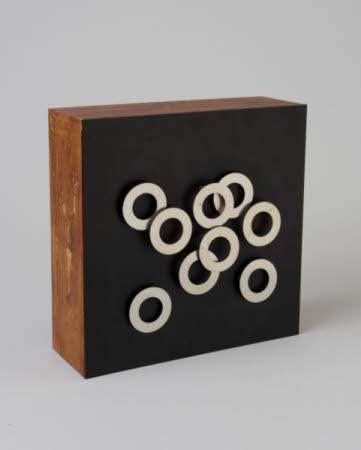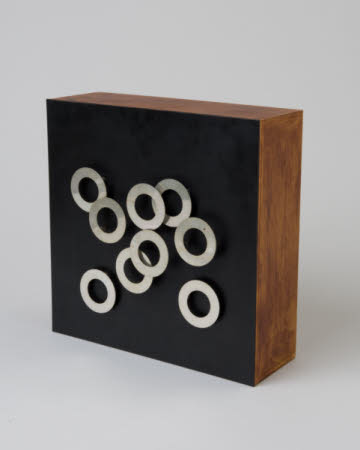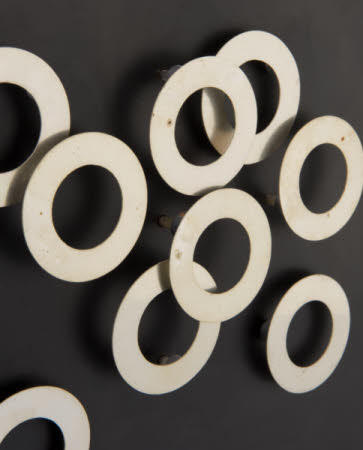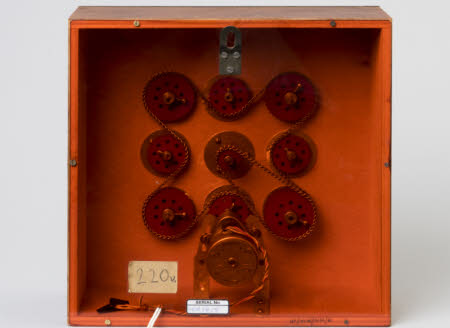Relief à déplacement continuel
Hugo Demarco (Buenos Aires 1932 - Paris 1995)
Category
Art / Sculpture
Date
1967
Materials
Laminate plastic, plastic and steel
Measurements
302 x 300 x 130 mm
Order this imageCollection
2 Willow Road, London
NT 112664
Summary
A kinetic sculpture, Relief à déplacement continuel by Hugo Demarco (1932-1995), 1967, comprising a rectangular wooden box with black laminate face, to which are affixed steel flat rings which rotate eccentrically at different speeds, when electric power is switched on. Perspex back, white plastic clad electricity cable issues from underside.
Full description
Relief à déplacement continuel (‘Relief with continuous movement’) is a kinetic ‘multiple’ by the Argentine artist Hugo Demarco. It comprises a wooden box faced in black laminate to which nine flat steel rings are attached. When electric power is switched on, the rings rotate at different speeds. It is an example of ‘kinetic art’: a type of art that incorporates movement, whether mechanical, environmental or perceptual, to achieve its full aesthetic and conceptual effect. It is thought that movement transforms the viewer's experience from one of passive observation to active participation. The present example is one of an edition of fifty ‘multiples’ (identical reliefs) produced by Demarco in 1967 for the influential Parisian gallerist Denise René (1913-2012). The term ‘multiple’ was coined and registered by René and essentially describes an art object that has been identically reproduced by the artist, usually for sale. For her, the multiple offered a ‘new method of distribution’ for works of art that particularly appealed to the young, fashionable, politically engaged art-buying audiences of Paris (‘An interview with Denise René by Jean Clay' in Denise René à Londres, exh.cat. 1968). She opened a gallery ‘entirely devoted to Multiple art’ on the Left Bank on the Boulevard St Germain. Relief à déplacement continuel was first exhibited at ‘Demarco, dynamique de l'image’ in 1968. It is likely that the Goldfingers acquired their multiple at the travelling exhibition, Denise René à Londres, hosted by the Redfern Gallery in London in 1968. For Demarco, and other kinetic artists working with multiples, this process of duplication served an important purpose – it denied the uniqueness and exclusivity of the art object and, by extension, the artist themself. As his contemporary Julio Le Parc wrote, ‘The multiple is located at the junction of artistic creation and industrial production. It protects the whole of the former as it offers the possibilities of the latter. This is one of the meeting points between art and the technology of our days.’ (Julio Le Parc, ‘Manifeste du Multiple’, c. 1966 quoted in Plante 2016). With its roots in Impressionism, kinetic art was adopted by artists associated with various twentieth century movements such as Constructivism and Dada. Pioneering works include ‘Kinetic Construction (Standing Wave)’ by Naum Gabo (1890–1977), 1919-20 (Tate, T00827) and ‘Bicycle Wheel’, 1913, the first ‘readymade’ kinetic sculpture by Marcel Duchamp (MOMA, 595.1967.a-b). Kinetic art experienced a major international revival in the 1960s, led by artists like Jean Tinguely and Nicolas Schöffer, and by artist groups such as ZERO in Germany, Gruppo T in Italy and Groupe de Recherche d’Art Visuel (GRAV) in France. Op Art (short for optical art, abstract art incorporating optical illusions) began to include real movement, while other artists created interactive kinetic environments. Hugo Demarco is best known for his contributions to kinetic and op art. Born in Buenos Aires in 1932, he trained at the Escuela Nacional de Bellas Artes before moving to Paris in the late 1950s. There he joined an international community of artists experimenting with light, colour and movement. Demarco was closely associated with this Paris-based collective GRAV, which created participatory art experiences that challenged ideas of passive viewing. One of the most important galleries promoting kinetic and Op Art, the Galerie Denise René regularly exhibited Demarco’s work. René had mounted the groundbreaking 1955 exhibition Le Mouvement, which positioned kinetic art by the established figures Alexander Calder, Marcel Duchamp and Victor Vasarely (NT 112434 and 814224) alongside work by the next generation: Yaacov Agam, Robert Breer, Pol Bury, Robert Jacobsen and Jean Tinguely. Hugo Demarco was one of the artists featured in the follow up exhibition, Mouvement 2, of 1964. Alongside artists like Le Parc, Gregorio Vardanega and Martha Boto, Demarco was part of a strong South American community contributing to the European kinetic art movement of the 1960s and 70s (see ‘Electric Shadows’ in Cameron 2017 for a fuller account).
Provenance
Exhibited at ‘Demarco, dynamique de l'image’, Galerie Denise René, Paris, April-May 1968; Denise René à Londres. Abstraction Géométrique, Lumière et Mouvement, Art Optique et Cinétique, Redfern Gallery, no. 44, 1968. Owned by Ernö Goldfinger and Ursula Ruth Blackwell, also known as Mrs Ernö Goldfinger. Purchased by the National Trust in 1994.
Credit line
National Trust Collections (2 Willow Road, The Ernő Goldfinger Collection)
Makers and roles
Hugo Demarco (Buenos Aires 1932 - Paris 1995), artist
References
Denise René à Londres, Abstraction Geometrique, Lumiere et Mouvement, Art Optique et Cinetique, Redfern Gallery, London 1968, Includes 'An interview with Denise René by Jean Clay' Popper 1968: Frank Popper, Origins and development of kinetic art, Greenwich, Connecticut 1968 Brett 1968: Guy Brett, Kinetic Art: The Language of Movement, London 1968 Brett, Grandas and Nash 2000: Guy Brett, Teresa Grandas and Mark Nash, Force Field: Phases of the Kinetic, exh.cat. Museu d'Art Contemporani, Barcelona, 2000 Cameron 2017: Dan Cameron et al, Kinesthesia, Latin American Kinetic Art 1954-1969, exh.cat., Palm Springs Art Museum, Palm Springs, California, 2017, p. 142 Isabel Plante, 'Kinetic Multiples: Between Industrial Vocation and Handcrafted Solutions', in Rachel Rivenc and Reinhard Bek (eds.), Keep It Moving? Conserving Kinetic Art, Getty Conservation Institute, 2018., https://www.getty.edu/publications/keepitmoving/theoretical-issues/13-plante/



